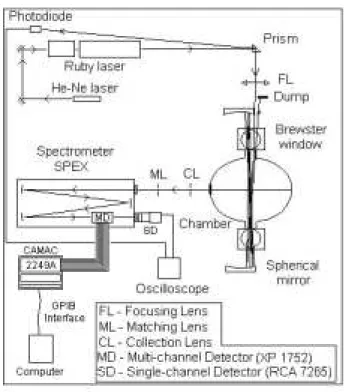Multihannel Photomultiplier for Multipass
Thomson Sattering Diagnostis
M.J. R. Monteiro, M. Mahida, A. M.Daltrini,and L. A. Berni 1
InstitutodeFsia\GlebWataghin", UniversidadeEstadualde Campinas,
C.P.6165,13083-970, Campinas,SP,Brazil
1
LAP/INPE-S~aoJose dosCampos,SP,Brazil
Reeivedon26June,2001
Theappliationofanewmultihannel64parallelampliation10stagephotomultiplierarranged
in8x8matrixof 20.32mmx20.32 mm,detetorXP1752fromPhilips, for laserlight sattering
diagnostis is now under development. Signal intensity alibration urve for eight parallel and
individualhannels,aswellasrosstalkbetweenhannelswasmeasured. Also,Rayleighsattering
onnitrogen gas, normally used as optialalibration method for eletron density measurements
in Thomson sattering was realized, and the intensity of both detetors was ompared making
measurementswithatungstenlamp.
I Introdution
Thomsonsatteringisoftenusedtomeasurethe
lo-aleletrontemperature,[1,2℄andeletrondensityan
bedeterminedifalibrationisdonebyuseofRayleigh
sattering [3,4℄. For this diagnosti method, one of
theritialissuesistheverylowsatteredlightsignal,
whihanbeinreased byuse ofa higherlaser power
orby passingthelaser beammany timesthroughthe
sameregionin theplasma,knownasmultipasssystem
[5-7℄.
Inour experiments, we use a 3J ruby laser, 40 ns
pulse width, and a multipass onguration with one
lensand twoonentrialspherialmirrorsto inrease
theinidentpowerand,onsequently,thesattered
sig-nal.
Throughthewidth ofthis Thomsonsattered
pro-le, we an measure the eletron temperature. But,
when asingle photomultiplier is used, oneneedmany
pulses of the laser beam as well as many disharges
ofourtokamakNOVA-UNICAMP[8℄,loosingtherefore
quiknessandaurayin ourmeasurements.
So,the purpose to usea multihannel
photomulti-plierinThomsonsatteringistoallowonline
measure-mentoftheeletrontemperatureanddensity,withone
shotof the laser beamand onedisharge of the
toka-mak.
Also,weanobtainradialinformation,thoughthe
spatial resolution of the detetor, improvingtherefore
theaurayinthemeasurementsandknowledgeofthe
II Experimental setup
Figure1. Experimentalsetup.
InFig. 1,weansee theexperimental setupused
for our measurements. The laser beam, after many
passages through the entral region, it is olleted in
abeamdump. Forthealignment,weused twoHe-Ne
Thespetrometer SPEXhas 75 m foal distane,
11
A/mmdispersionrelation,andpermitstousetwo
detetors. Byrotationof ainternal mirrorwean
se-let, thesinglehannel detetor, photomultiplier RCA
7265,orthemultihannelphotomultiplier,XP 1752.
Eah hannel of XP1752 detetor has 2.54 mm x
2.54mmofsensitivearea,spetralresolutionof
approx-imately 27
A, 5.0 ns response time, 10 stage dynodes
with gainof1x106at1150V, andallowstomeasure
FWHMof Gaussianshapesatteredlightfrom8nm(
6eV)to 80nm(600eV).
The single hannel photomultiplier has a response
timeof3.5ns,14stagedynodes,andgainof2x10 6
at
1800V.
Thesignalsfromthedetetoristakenbyanalogto
digitalonverters,ADC, LeCroy2249Aandontrolled
withGPIBtoaPC,providingonlinemeasurementsof
satteredlightvariationbywavelengths.
III Results
The64hannelshavebeensetto8parallelolumn
out-puts. Eah olumn outputoversall spetrometer slit
height,andonespetralwidth of27
A.Signalintensity
alibration urves for this eight parallel hannels was
measured,in therangeof620nmto 642nm,sanning
aHe-Nelaser,Fig. 2.
Figure2.Intensityalibrationurvesofthe8parallel
spe-tralhannels,1to8,fromrighttoleft,ofthemultihannel
detetorXP1752.
The ross talk between hannels is dened as the
inuene of signal in one hannel aused by adjaent
hannel. If we observe the right and left sides of the
Fig. 2, olumn hannels 1 and 8 respetively, we see
thatthestraightlineatthebottomofsignalsisdueto
the lakofadjaent hannels. So, theinuene ofone
hannel on theadjaenthannel appears as thesmall
area surrounding the harateristi area of the signal
in the hannel. So,theross talk isthe ratiobetween
theareasoftheinuenesignal,A1,andharateristi
Figure3.Crosstalkausedinthehannel4bythehannel
5.
Measurements using He-Ne laser, slit aperture of
100mm,showthat themeanrosstalk between
han-nelisabout14%.
Formorepreiseharaterizationofthe
multihan-nel photomultiplier, intensity alibration of the64
in-dividualhannelswasalsomeasured,Fig. 4.
InFig. 4,eahspetralhannelhas27
Aresolution
andeahspatialhannelovers2.5mmslitheightwith
100mm slit aperture of the spetrometer. We notie
that there is 5.4 intensity variation between hannel
(4,5)andhannel(1,8)whihisinaordanetoother
measurements[9,10℄.
Figure4.Intensityalibrationforthe64individualhannels
ofthemultihannelphotomultiplierXP1752.
def-individualdetetors inthespetralhannel4,as
fun-tionof theslit height,Fig. 5. Again,weuseaHe-Ne
laserand theslitapertureof100mm. Notie thatfor
fullslitheightopening2.5x8,wereproduethe
spe-tralhannel4ofgure4.
Figure5. Intensityvariationofthespetralhannel-4eight
detetorasfuntionoftheslitheight.
Rayleighsatteringmeasurementson nitrogengas,
normally used as optial alibration method for
ele-trondensitymeasurementsinThomsonsattering,was
donetotestthemultihanneldetetor,Fig.6.
Figure 6. Calibration urvefor Rayleighsattering on
ni-trogengasusingonespetralolumnhannel(hannel6)of
themultihannelphotomultiplier.
As we an see, the approximatelylinear variation
ofthe signalswith thepressureis harateristiofthe
alibrationurveforRayleighsattering.
Finally,usingatungstenlampandthesame
exper-imental set up,wemeasure theintensities ratioofthe
signals at harateristi values of working voltage for
single(1800V)andmultihanneldetetor(4,5)(1400V)
Figure7.Intensitymeasurementsforsingleand
multihan-nelphotomultipliersusingatungstenlamp,notiethatthe
ratioisaboutvetimes.
IV Conlusions
CharaterizationofthemultihanneldetetorXP1752
hasbeendonewiththepurposeofuseonThomson
sat-teringmeasurements. Thisdetetorprovidesboth
spe-tralandspatialresolutions,andsamerangeofintensity
ompared tosinglephotomultiplier,whihshould
on-tributetoaurayandquiknessontheloaleletron
temperatureanddensitymeasurements.
Aknowledgements
The authors would like to thank FAPESP and
FINEPforthenanialsupport.
Referenes
[1℄ M.Bassan,R.Bilato,L.Giudiotti,R.Pasqualoto,and
A.Sardella,Rev.Si.Instrum.68,718(1997).
[2℄ A. Cte, D. Mihaud, N. Rihard, R. Neufeld, and
C.Legros,Rev.Si.Instrum.66,487(1995).
[3℄ L.A.Berni,D.O.Campos,M.Mahida,S.A.
Moshka-lyov andS.V. Lebedev; Brazilian Journalof Physis,
26,755(1996).
[4℄ D.G.Nilson,D.N.Hill,J.C.Evans,T.N.Calrstrom,
C.L.HsiehandR.E.Stokdale;Rev.Si.Instrum.68,
704(1997).
[5℄ M. Yu. Kantor and D. V. Kouprienko; Rev.Si.
In-strum.70,780(1999).
[6℄ M. Yu. Kantor; Tehnial Physis Letters, 23, 671
(1997).
[7℄ M. Yu. Kantor; Tehnial Physis Letters, 25, 860
(1999).
[8℄ M. Fukao, K.Mori, T.Tanihara; PlasmaPhys.
Con-trol.Fusion,33,199(1991).
[9℄ J.P.Boutot,P.LavouteandG.Eshard;IEEETrans.
Nul.Si.,34,449(1987).
[10℄ L. Eriksson et al.; IEEE Trans. Nul. Si., 34, 344


